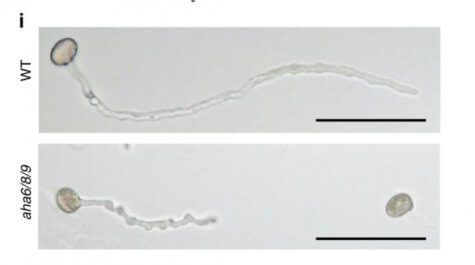COPENHAGEN, Denmark — Here’s a piece of information you probably weren’t expecting to learn today: the sexual organ of a male pollen grain grows to be several thousand times longer than its usual length as it moves toward a female egg cell. That’s, well, quite an accomplishment from a human perspective. It’s especially astonishing for scientists, who have long been puzzled as to how exactly pollen “penises” reach such great lengths.
Now, however, new research from the University of Copenhagen offers some long-needed answers regarding pollen grain penises, or pollen tubes. Moreover, these discoveries may prove useful when it comes to understanding human nerve cells.

According to the study, pollen tube elongation is driven by an electrical circuit and powered by microscopic pumps called “proton pumps.”
“We were taken aback by how extremely advanced the plant’s fertilization mechanism really is. From textbooks, we understand that pollen tubes grow and push forth by continually building additional floors upon the cell skeleton, like a growing scaffold,” says Professor Michael Broberg Palmgren from the Department of Plant and Environmental Sciences in a release. “However, very little was known about the underlying mechanisms of this enormous growth. Our work has made the world a bit wiser.”
Pollen tube’s search for an egg
Comparable to a dog sniffing out food, the research team says that a pollen tube “smells” its way to an egg cell after arriving on the female part of a flower. Once the pollen tube finds its target, its tip starts to extend. This process is called “tip growth.”
Thale cress, a weed plant, was used for this study and researchers say pollen tubes grew roughly three millimeters each day during their experiments.
“The pollen tube is not a rigid tube. It is dynamic and can redirect as it searches for an egg,” explains Palmgren.
This discovery was made by changing a group of genes called AHA in tested plants. Those genes facilitate the development of proton pumps. Those proton pumps are what control acid levels in the pollen tube and produce electrical voltage across the cell membrane. The study’s authors hypothesize that these AHA genes are linked to pollen tube growth, so they started “switching off” different gene combinations and observed what happened.
“In experiments, we were able to see that the ‘mutant pollen tubes,’ in which we had switched off the genes, were dramatically delayed in their growth and had difficulty finding their way,” professor Palmgren notes.
‘Tip growth’ may help humans?
Beyond just the relevance of these findings to plant reproduction, the study’s authors also feel that their work can benefit humans.
“Very little is known about what controls nerve growth — which is hugely important for recovery from nerve or brain damage. Here, our result might prove useful for better understanding the process of ‘tip growth’, which is how the human nervous system grows as well,” says Palmgren.
“The more we investigate, the more advanced plants turn out to be. There are no arguments to suggest that plants are any less than us humans,” he concludes.
The study is published in Nature Communications.
Like studies? Follow us on Facebook!
